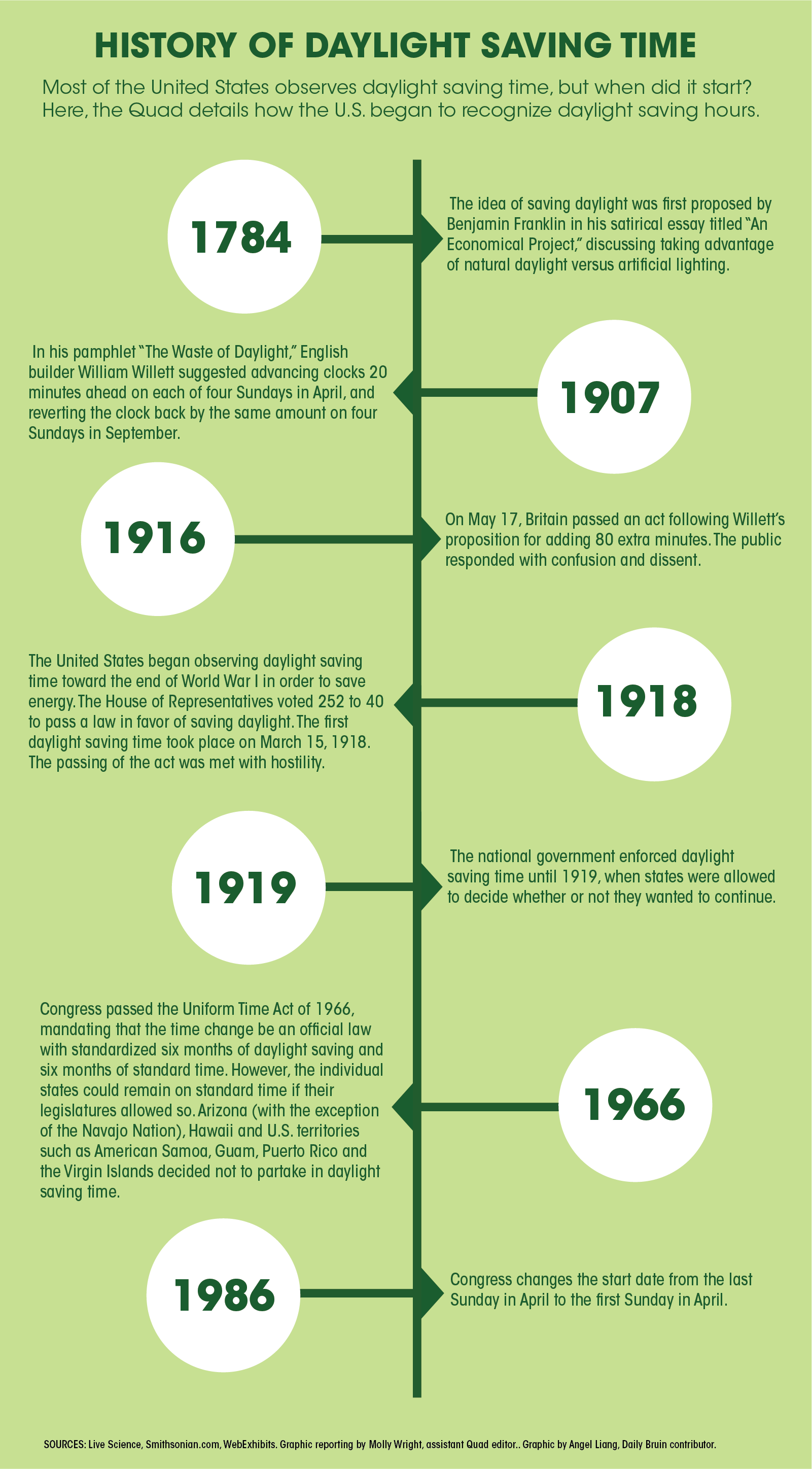The Quad: History of daylight saving, how changing time policies could affect California

By Elizabeth Hanczor
March 12, 2019 1:31 p.m.
On top of finals, papers and the looming sense of anxiety that come with the end of the quarter, the last thing I needed this weekend was to lose an hour of sleep Sunday morning.
But when my clock sprang forward, so too did my sleep schedule.
Coupled with the annual exhaustion, daylight saving time actually has a complex relationship with local and federal governments across the world. Californians of voting age are sure to have some understanding of the clock change’s controversial connection to their home state, especially after Proposition 7’s success in the last election cycle. Understanding daylight saving’s humble beginnings is important in analyzing the recent legislation that has affected California and other states.
In the 2018 midterm election, Proposition 7, which aimed to put permanent DST back on the table, passed with a 60 percent favorable vote. With this measure, the California legislature has the power to vote to keep daylight saving time permanent – a decision that may consequently help stabilize student sleep cycles going into week 10 next year.
[RELATED: Editorial: Yes on Proposition 7]
The first recorded act of “saving daylight” was observed by New Zealand entomologist George Hudson in 1895. Hudson didn’t just propose to change clocks by one hour though – he proposed moving the clock two hours up, to have even more time to work under the sun.
Hudson never gained significant publicity for his idea though. However, William Willett, a British builder, managed to gain government recognition and support for an almost-identical concept, later, in the 20th century.
In his pamphlet “The Waste of Daylight,” published in 1907, Willett argued that moving unused hours of daylight from the morning to the end of the day would conserve energy and provide people with more time to spend outside in the sun after work. Despite the support from important dignitaries like Winston Churchill, Willett’s plan was never formally adopted by the British Parliament.
However, world leaders needed to think of fast ways to save money and energy when World War I broke out – and the simple solution was, quite literally, saving daylight. Once Germany made the decision to alter its clocks biannually in 1916, the other world powers quickly followed suit. The United States instituted its first daylight saving law March 9, 1918.
This militaristically driven decision has come to irritate the countries and states closest to the equator, especially Arizona, and most recently, California.
The tropical nations that lie in between both hemispheres typically do not observe daylight saving. Because seasonal changes in daylight are so minimal at the equator, there is little reason for countries to implement compensational policies.
Though not the closest state to the equatorial divide, Arizona has gone against the political grain and opted not to observe daylight saving. DST began at the outbreak of World War II as “wartime” was established and permanently adopted under the Uniform Time Act of 1966. This law called for every state to turn their clocks forward an hour at the beginning of spring. After enduring one sweltering summer, Arizonans realized more daylight meant hotter nights, more air conditioning and increased energy usage. The following year state legislators voted almost unanimously to remain in standard time year-round.
Unfortunately for other states trying to change time policies similar to that of Arizona, permanently rolling the clock forward has proven far more difficult than rolling it backward. The Uniform Time Act had a catch – states could opt to remain on standard time year-round, but could not choose to solely observe daylight saving time.
Aside from logistical concerns regarding the transition, new health concerns have grasped the attention of government leaders.
Researchers at Johns Hopkins and Stanford University found that shifts in daylight saving time causes spikes in the number of fatal car accidents recorded yearly. They noticed after the fall back change, more accidents occur over the weekend, likely related to long nights out, and during the spring forward change, more accidents occur on the following Monday, likely linked to sleep-deprived commutes to work.
Additionally, researchers from the Department of Public Health Sciences have also discovered a correlation between heart attacks and sleep deprivation. After comparing the incidences of heart attacks from the week after the spring forward shift and the rest of the calendar year, they found a significant spike in heart attacks after the time change.
Inconsistencies in state-to-state time changes will affect the United States as a whole. Looking to the future, if California legislature votes to formally adopt a consistently sunny clock, several logistical kinks will impact other states. No matter how much leverage each has, the actions of one inextricably affect the others.
But who knows – maybe this time next year, we won’t be changing our clocks. California may just be the first domino to tip, forever redefining what we consider “falling back” and “springing forward.”


